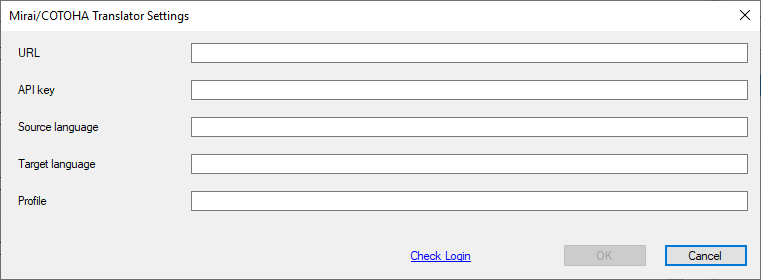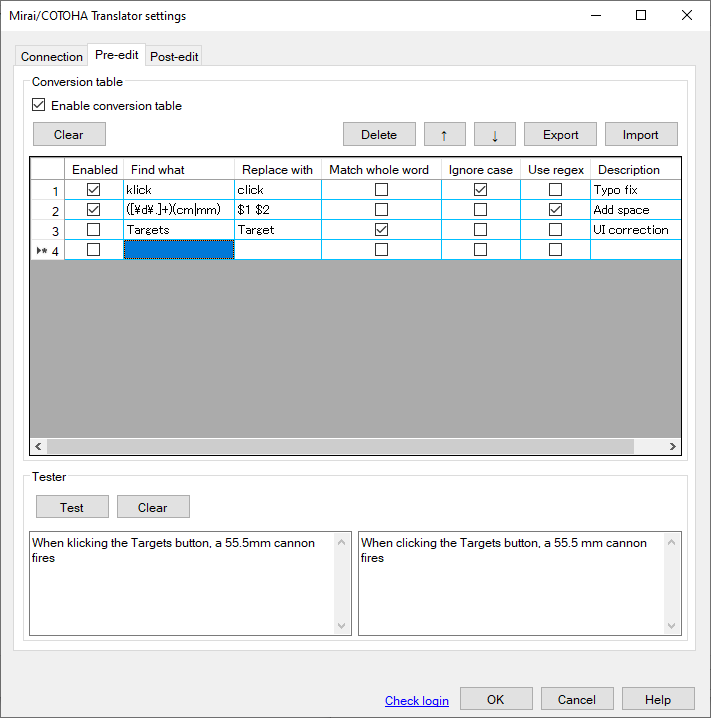Mirai/COTOHA Translator
Set up the Mirai/Cotoha Translator to work with memoQ.
How to get here
For a local profile:
- At the top of the memoQ window, in the Quick Access toolbar, click the Options
 icon. The Options window opens.
icon. The Options window opens. - On the Default resources pane, click the MT settings
 icon. The MT settings pane appears.
icon. The MT settings pane appears. - Select the MT profile you are using and under the list, click Edit.
- On the Services tab, find the plugin and click its row. If it is turned on, click its row to open the Mirai/COTOHA Translator window. If it is turned off, click its row once to turn it on, then click it again to open the settings.
For an online profile:
- At the top of the memoQ window, in the Quick Access toolbar, click the Resource console
 icon. The Resource console window opens.
icon. The Resource console window opens. - In the Server URL list, choose or type the server's address. Click the Select
 button.
button. - In the left-side pane, click the MT settings
 icon. The MT settings pane appears.
icon. The MT settings pane appears. - Select the MT profile you are using and under the list, click Edit.
- On the Services tab, find the plugin and click its row. If it is turned on, click its row to open the Mirai/COTOHA Translator window. If it is turned off, click its row once to turn it on, then click it again to open the settings.

What can you do?
Set up access to the service
- Get access: Subscribe to the service.
- On the Connection tab, enter the service URL, your API key, the project's Source language, Target language, and your Profile name.
- Click the Check login link. memoQ validates the information you entered.
Use text conversion before or after machine translation
Sometimes you need to replace parts of the source text before you send it to the MT service (use the Pre-edit tab), or parts of the target text you receive from the MT service (use the Post-edit tab). Both tabs work the same way.

Add rules to the conversion tables as needed. Each rule works like a "search and replace" action in text editors (or in memoQ): text you write into the Find what column will change to the text in the Replace with column. The plugin processes rule 1 first, then rule 2, etc. If a rule is not Enabled, the plugin ignores it.
To clear the whole table: Click the Clear button.
To delete a rule: Select it, and click the Delete button.
To move a rule up or down in the list: Select it, and click the Up arrow or Down arrow button.
To export the table into an UTF-8 encoded, tab-separated text file: Click the Export button, and save the file.
To import an UTF-8 encoded, tab-separated text file into the table: Click the Import button, browse to the file, select it and click the Open button.
You can test your conversion table. In the Tester region, copy and paste (or write) text into the left text box. Make sure the text box contains the Find what texts of the rules you want to test. (Make sure you enabled the rules you want to test.) To run the test: Click the Test button. To clear the left text box: Click the Clear button.
When you finish
To save the settings, and return to the Default resources tab of the Options window (or to the Resource console): Click OK, then click OK again.
To return to the Default resources tab of the Options window (or to the Resource console), but not save the new settings: Click Cancel, then click Cancel again.
To use the MT output in the translation editor:
- Open a project with a supported language pair.
- On the left side of the Project home or memoQ online project screen, click Settings.
- In the top bar, click the MT settings
 icon.
icon. - Choose the MT profile in the project, or one you want to add to the project. Below the list, click Edit.
- On the Services tab of the Edit machine translation settings window, check the plugin's check box on the left.
- On the Settings tab of the Edit machine translation settings window, in the Translation results area, choose a setting other than Off.
- Open a document for editing, and see the machine-translated suggestions.
To use the MT output in pre-translation:
- Open a project with a supported language pair.
- On the left side of the Project home or memoQ online project screen, click Settings.
- In the top bar, click the MT settings
 icon.
icon. - Choose the MT profile in the project, or one you want to add to the project. Below the list, click Edit.
- On the Services tab of the Edit machine translation settings window, check the plugin's check box on the left.
- On the Settings tab of the Edit machine translation settings window, select the plugin from the Pre-translation dropdown.
- Run Pre-translate. In the Pre-translate and statistics window, check the Use machine translation if there's no TM match check box. (memoQ will remember this.)